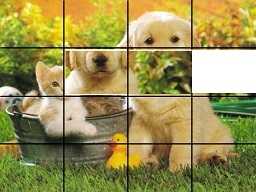14
6
Summary
The goal of this challenge is to create an undone image-version of a 15-puzzle / sliding puzzle also called taquin in french.
Details:
Given an input composed of:
- an image,
- an integer
n, - an other integer
r,
your program, or function, or anything else that fits, must output the same image (i.e. same size and format) as the input, but that underwent the following process:
- divide the image into
n²rectangles, - remove one of those rectangles, randomly,
- move a random number of contiguous rectangles from the line/column affected by point (2.) so the hole created is filled and another one is generated in this line/column. This number can be
0if the blank is in a corner or an edge.
Repeat (3.) r times.
Clarifications:
- If you moved rectangles from the line in step (3.), you must move rectangles from the column the in the next repetition,
- if you moved rectangles left-to-right in a line-step, they must be moved right-to-left in the next line-step, same for top-to-bottom and bottom-to-top concerning columns,
- you may assume that
nwill be chosen so it divides the lengths of the sides of the picture.
A last point:
An animated .gif showing the whole process are very welcomed.
I propose to use the following picture (which is 1024x768), with n=16 and r=100 as a model, you can use any other picture (as long as it's relevant and complies with SE's rules, of course).
Note that standards loopholes policies apply.
This is code-golf, so the shorter submission wins !
Since an example was requested, here is one, made "by hand", with n=4 and r=1
Steps 1 and 2
Step 3 : line-wise, 2 rectangles to the left




The example suggests that the rectangles do not need to be the same size, do not need to cover the entire image, and should include lines drawn over the original image. Could you clarify this, by either changing the specification or the example? – trichoplax – 2017-02-19T19:45:02.353
@trichoplax : the example was drawn by hand with paint and quickness. I will redo-it properly. – Frédéric – 2017-02-19T19:46:23.787
@trichoplax : I must admit that I don't completely get your point, but this opening line isn't needed to understand the challenge, so I guess it's useless to keep it. – Frédéric – 2017-02-19T20:03:27.713
move a random number of contiguous rectanglescan it be 0 rectangles? (it would be a pain to make the program change behavior when the blank is on an edge/corner) – JungHwan Min – 2017-02-19T20:07:32.937@JungHwanMin : yes it can. Good remark, thanks ! – Frédéric – 2017-02-19T20:10:04.347
Sorry I don't really understand what the random number is for in Step 3. Cold you elaborate? At first I thought it was the number of times to move a rectangle, but that appears to be
r. Also, what does it mean that it can be 0? – Kodos Johnson – 2017-02-20T21:42:13.867@KodosJohnson The random number of step 3 is the number of rectangles you move at a time in this step. It can be 0, if you're stuck on a corner or an edge.
ris the total number of repetitions of this step. – Frédéric – 2017-02-21T07:13:55.343As a point of interest, cycling any 3 tiles will always result in a solvable state, and generally produces a much better shuffle. – primo – 2017-02-24T11:12:46.577
@primo : Thanks for the comment ! How do you come up with this conclusion ? – Frédéric – 2017-02-24T12:26:07.580
@Frédéric AF Archer provides a fairly elegant proof in this paper (proof of Lemma 1, Theorem 3). In essence, he is showing that each single piece slide can be obtained by 3-cycles, and thus all of A15 (note that the pieces are numbered slightly out of order to obtain this proof).
– primo – 2017-02-24T12:46:55.070@primo : thanks for the ref ! I'll read that, and perhaps add to the challenge the possibility to move
3squares at every step ! – Frédéric – 2017-02-24T13:13:17.113